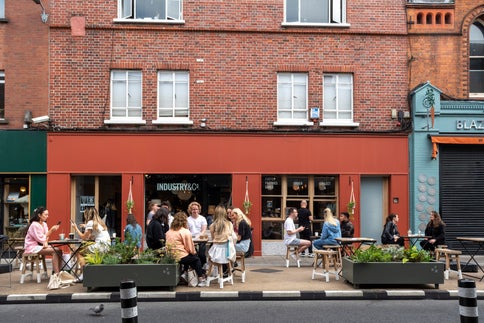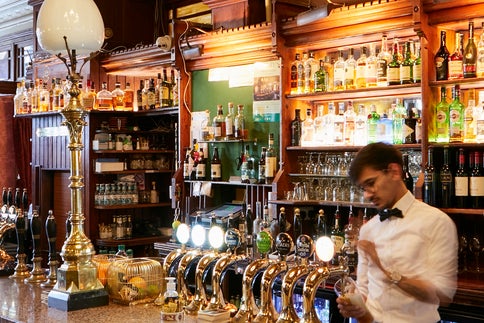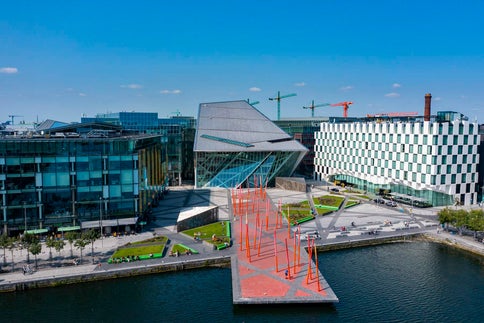- Home
- Traveller guides
- Dublin Secrets: Lamplighters of the Phoenix Park
Dublin Secrets: Lamplighters of the Phoenix Park


When evening falls in Dublin, the Phoenix Park takes on an extra touch of magic.
Stand on Chesterfield Avenue as dusk settles, and you’ll see the Victorian gas lamps lining the road flicker to life one by one, casting warm pools of light on the ground below. This soft, misty glow appears just as it did over a century ago, with Dublin one of the few remaining cities worldwide still using gas lighting.
These gas lamps have long been intertwined with one Dublin family. The Flanagans have tended them since 1890, making them as much a part of the city’s fabric as the flower sellers of Moore Street or the gravediggers of Glasnevin Cemetery. Today, Jim and Frank Flanagan care for the same lamps their grandfather maintained generations ago, keeping one of Dublin’s most distinctive traditions alive.
A family affair
Jim Flanagan has worked as a lamplighter in the Phoenix Park for over 40 years. On the day we meet, his brother Frank isn’t well. But that doesn’t mean the park is far from his thoughts.
“I’ll go to my brother Frank this evening,” says Jim. “And the first thing he’ll say to me is ‘How is the park?’”
The Phoenix Park has been a part of the Flanagan family for as long as Jim can remember, and while he has only been officially working as a lamplighter since the 1980s, he was helping out his father Tom long before then. “No matter what I did, I was always in the family business,” he says. A welder by trade, he also drove articulated trucks, then worked for Bus Éireann but would always come back to the lamps at the end of his working day.
Although Dublin introduced its first electric street light in 1880, the city also installed over 300 gas lamps in Phoenix Park that same year. The Flanagan family's lamplighting legacy began a decade later in 1890, when Nicholas Flanagan and his four brothers took on the responsibility of servicing every lamp in the park.
The Flanagans carry on this legacy today, maintaining 224 gas lamps along Chesterfield Avenue and nearby pathways. Jim and Frank, third-generation lamplighters, now work alongside their grandsons and sons-in-law, who are keenly embracing the family tradition.

Every day at sunset, they prop a ladder against the ornate cast-iron lampposts, climbing up to clean the lanterns, inspect each light and check the mantles – the delicate silk casings that function like lightbulbs. These mantles are often damaged by the wind or may not illuminate properly. The next morning, they revisit any lamps needing attention and carry out the necessary repairs.
They also manually wind the century-old timers in each lamp every 14 days, ensuring the lights come on at just the right time for the season. Each timer is set to turn the gas on and off automatically, so the lamps begin to glow just as the sky darkens.
A long and winding road
In the early days, before timers existed, the Flanagans would use a long pole to light the lamps manually each evening and return in the morning to extinguish them. Surprisingly, these timers were not a modern addition; they date back to the 1920s, when Jim and Frank’s father first began working in the park.
While the timers made the job less demanding, they had a significant impact on other lamplighters in the city, many of whom lost their jobs – especially those who had already managed to survive the transition to electric lighting. The Flanagans, however, kept the old gas lamp tradition alive with a reduced team, consisting only of Nicholas and his son, Tom.

Changing times
There’s a certain romance when the gas lamps flicker to life each evening. They look exactly as they did 134 years ago, evoking a sense of nostalgia that only gas lighting can create. Switching to electric lights would break this spell entirely – losing the warmth and charm that makes these Victorian lamps so distinctive.
Over the past century, there have been discussions about converting the lamps to electric or automating the system entirely. But thankfully, this has never happened. If it did, we’d lose the classic Victorian posts, as electric lights would require taller fixtures to cast adequate light. More importantly, the quality of light would be starkly different.
“If you were up here in the evening and saw these lighting up, you’d see they’re absolutely gorgeous,” says Jim. “There’s a reddish glow - they’re nothing like electric lights. An electric light here would feel like being in the middle of Dublin.”

A front seat to history
Over the years, the Flanagan family has witnessed many historic moments in Phoenix Park – from the raid on Magazine Fort at the start of the Easter Rising in 1916 to the mass led by Pope John Paul II for 1.25 million people in 1979. And at the close of each of these significant days, the lamps of Phoenix Park faithfully flickered to life.
In addition to witnessing key moments in Dublin’s history, the Flanagans have had personal encounters with political figures in the Phoenix Park. Beyond maintaining the 224 gas lamps, they are also responsible for the upkeep of 124 electric lights at Áras an Uachtaráin, the official residence of the Irish president. This role occasionally brings them inside the residence, as it did recently with a meeting with current president Michael D Higgins. “We were actually invited in for tea only last year,” says Jim. “We had a great time. I sang him a couple of songs.”
Preservation of wildlife
While presidents and diplomats (the park is also home to the US ambassador’s residence) may be some of Phoenix Park’s most famous residents, they’re not its longest-standing ones. That distinction belongs to the herd of around 600 fallow deer that roam its fields and meadows. Introduced to the park in the 1660s, some of the deer you see today are direct descendants of that original herd.

Over the years, the Flanagans have had many an encounter with the wildlife in the park – hearing the clash of antlers during rutting season and seeing badgers and foxes shuffling around in the undergrowth. There are thousands of different species who reside in the park, from beetles and crickets to buzzards and squirrels (not including the more exotic creatures in Dublin Zoo, of course). The soft, unobtrusive light from the lamps creates a pleasant atmosphere for them all, and doesn’t disturb any of the park’s nocturnal animals.
“It’s very good for wildlife,” says Jim. “If you had the type of [electric] light we have now, that’s not so good. But this light here doesn’t affect them in any way. Particularly the insects and smaller animals.”
A job for all seasons
A lamplighter’s work is never done, and it certainly doesn’t stop in bad weather. They need to look after the lamps every single day of the year, whether the ground is thick with snow or the wind is strong enough to knock you off your ladder. In Donal Fallon’s The Lamplighters of the Phoenix Park, Frank Flanagan recalled the stories from his predecessors. “They worked seven days a week, in all weather… they all remembered the big storm of 1903, when hundreds upon hundreds of trees were taken out of it. I can recall Nicholas saying as many as three thousand trees were lost to the storm.”
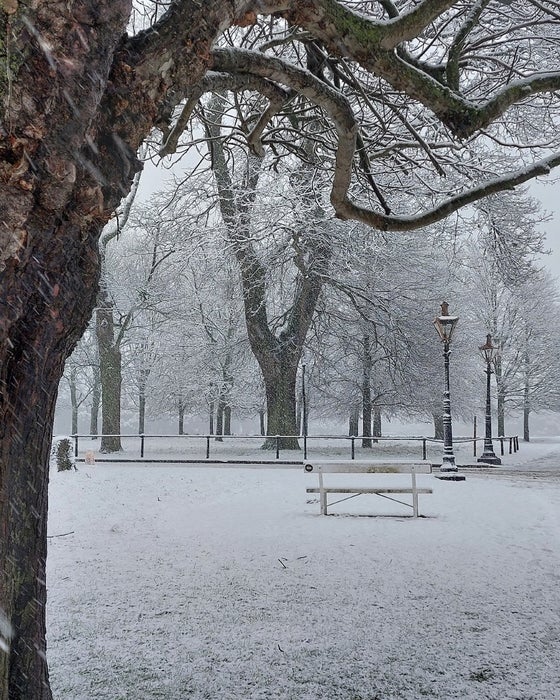
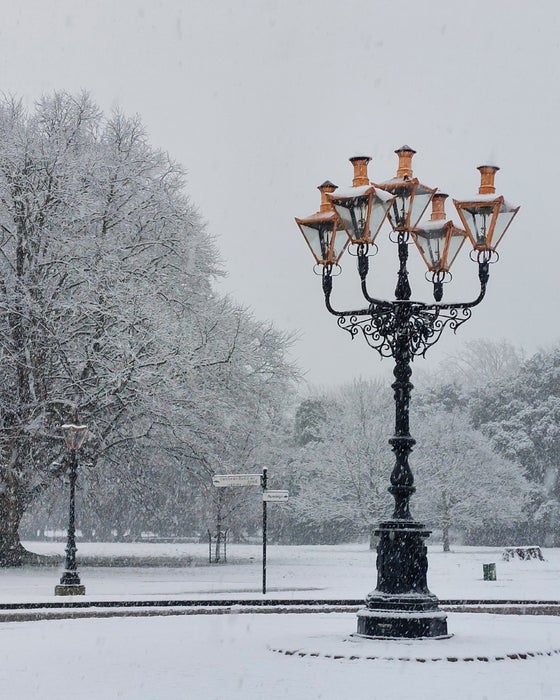
But while winter can be a brutal season for the job, Jim’s favourite time comes just before, in the autumn. When the leaves start to turn and the clocks go back, he loves having a front row ticket to the transition of the seasons. “The colours in the park are absolutely beautiful, the temperature is just right. That’s my favourite time.”
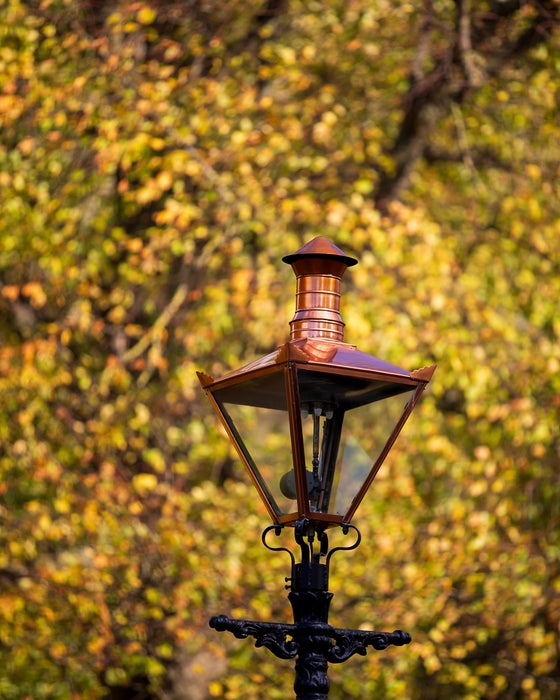
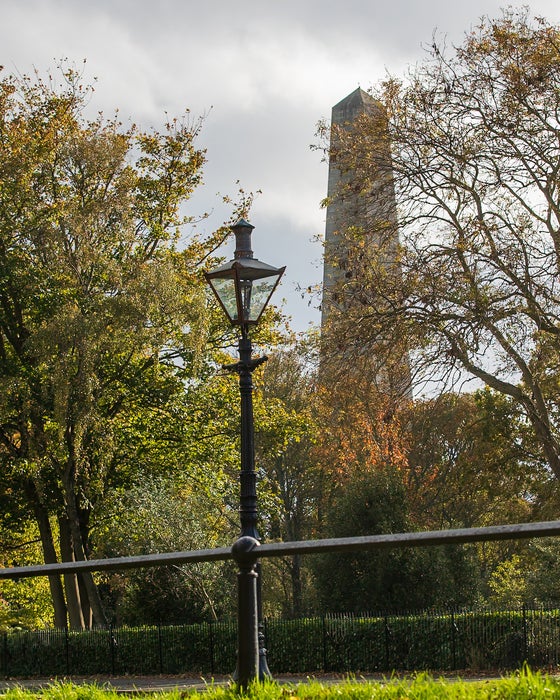
The last of their kind
At one time, many European cities lit their streets with gas lamps, but today Dublin is one of the few that still does. Gas lamps can also be found along the Charles Bridge in Prague, as well as in Wroclaw and London, where Westminster’s lamps are still maintained by hand. Berlin, once home to a vast network of gas lamps, has significantly reduced their number – from 44,000 in 2014 to around 20,000 today – with plans to eventually replace most with electric lighting.
The tradition may be dying around the world, but for the moment, it’s holding strong in the Phoenix Park. “Eventually, if it becomes a point where [greater] illumination is needed, at that stage they’ll probably change to electric,” says Jim. “We don’t know. But that’s not going to happen in the next ten years.”
Keeping the home fires burning
After almost 40 years in the role, Jim hasn’t lost his grá (love) for the lamps. “Starting out in the morning, meeting my first lamp, and working out what I have to do in the day. That’s my favourite part. Because I love doing it. I’ve never lost the yearn[ing] to be doing what I’m doing.”
He may be in his eighties, but after all these years, there’s nothing he loves more than checking in on his park, going up the ladders and then reporting the news back to Frank at the end of the day.
What to do in the Phoenix Park
Want to explore Europe’s largest enclosed city park? There’s plenty to see and do throughout the year, whether you want to ramble the walking trails or take a tour of a famous residence. It’s a huge green space so you might want to rent a bike to get around - Phoenix Park Bikes is at the Parkgate St entrance, while Dublin Bus Route 99 serves the park from Parkgate St as far as the Phoenix Park Visitor Centre.

Say hello to the deer
If you’re lucky, you might spot the beautiful deer as they graze in the park, or hear the sound of their rutting in the autumn. Just remember that they’re wild animals, so stay at least 50 metres from them and definitely don’t try to feed them.
Tour the Áras an Uachtaráin
Did you know that you can take a free tour of Áras an Uachtaráin? These guided tours of the official residence of the Irish president take place almost every Saturday, with tickets given out on a first come, first served basis from the Phoenix Park Visitor Centre, next to Ashtown Castle. The centre has some fascinating exhibits on the history of the park, offers free guided tours of the castle and also has a lovely café onsite.
Visit the official state guesthouse at Farmleigh
The third in a trio of fine Palladian mansions in the Phoenix Park (after Áras an Uachtaráin and the residence of the US Ambassador), Farmleigh House is where high-level guests of the Irish State are hosted. At other times, the house can be visited by guided tour while the grounds host regular craft and food markets.
Have a cuppa in the Tea Rooms
Another fixture of the park that’s been on the go since the 1800s, the Phoenix Park Tea Rooms are just off Chesterfield Avenue, and a great place to go for a pot of tea and slice of homemade cake.

Visit Dublin Zoo
One of the oldest zoos in the world, the Dublin Zoo has been open since 1831. Known for their conservation work, the zoo is home to everything from elephants and giraffes to flamingoes and red pandas.
Explore the Furry Glen
Jim’s favourite part of the Phoenix Park, the Furry Glen is one of the lesser visited spots, on the Chapelizod side. Head down for a peaceful stroll through the woodland and around the pond.
Find out more of Dublin's secrets
Continue to uncover Dublin's weird and wonderful side by visiting the city's most unusual attractions.

